Bringing in short-term employees is often a business necessity, but hiring freelancers can sometimes feel like driving in the dark.
While a quick browse through a services marketplace will yield hundreds (if not thousands) of skilled remote workers with high-quality work on display, freelancers sometimes lack the right motivation to succeed.
If you’ve had trouble finding the right independent contractors, then this guide to hiring freelancers the right way is just for you. We’ll explore how to decide whether freelancers are right for your business and suggest seven steps to find the ideal freelancer for any role.
TL;DR – Key Takeaways
Hiring freelancers is a good option for companies that need to fill skill gaps, expand quickly, or complete one-time projects. They bring fresh insights and expertise to projects.
As a flexible resource, freelancers don’t carry the cost overheads associated with permanent employees. But the cons are plentiful, too, from questionable loyalty and haphazard communications to increased pressure on managers.
Plan the recruitment process strategically. Consider payment options and create an informative job post. Post the position on relevant freelancing platforms and leverage personal networks where possible. Narrow down your options and mix interviews, skills assessments, and portfolios to find the right expertise.
A fast and reliable way to find great freelancers is by getting them to demonstrate their skills. Whether you’re hiring a freelance writer or a developer, a 15-minute skills test gives you better insights into their practical know-how than a project catalog or online portfolio.
How do you know you need a freelancer vs. a full-time employee?
Before we explore the ABCs of hiring freelancers, let’s start with a fundamental question: Do you actually need a freelancer, or will internal employees be just as effective?
After all, bringing in freelancers can disrupt settled teams, make full-time employees feel uneasy about their security, and cause managers to feel less connected to them than to permanent colleagues.
Nevertheless, there are definitely some scenarios where choosing to hire freelancers makes sense. Generally speaking, using independent contractors is advisable for:
Short-term projects: Freelancers work well when you need to complete one-off projects with a defined scope. As a business owner, you’ll likely get more value out of hiring a freelancer for a short-term project than for a long-term, ongoing project (where it would likely make more sense to hire a dedicated account manager or full-time employee).
Skills gaps: If your team lacks specialized skills for a given project, freelancers can step in. For instance, you might need freelance developers to build an app or IT system, or you might need help with financial consulting to help make sense of one-off accounting issues. Smaller companies often enlist contractors for these one-off technical tasks.
Cutting costs: In the long term, it’s usually better to recruit full-time employees, but freelancers don’t have added costs for small business owners, like benefits and pensions. That can make them a short-term cost-saving solution.
Maintaining flexibility: Companies can bring in groups of freelancers to deal with spikes in activity like major trade fairs or seasonal events.
Global expansion and remote work: Freelance job boards and networks provide access to top global talent. Companies can dip their toes in the pool to recruit expertise and create a presence in other regions without the costs of building a permanent team.
Broadening your horizons: Internal teams can become stale and homogeneous. When that happens, bringing in freelance talent can enrich your perspectives. This can help improve work quality and improve diversity.
The bottom line? It pays to think carefully about your hiring strategy. If you need short-term help or access to scarce skills, hiring freelancers could be the answer.
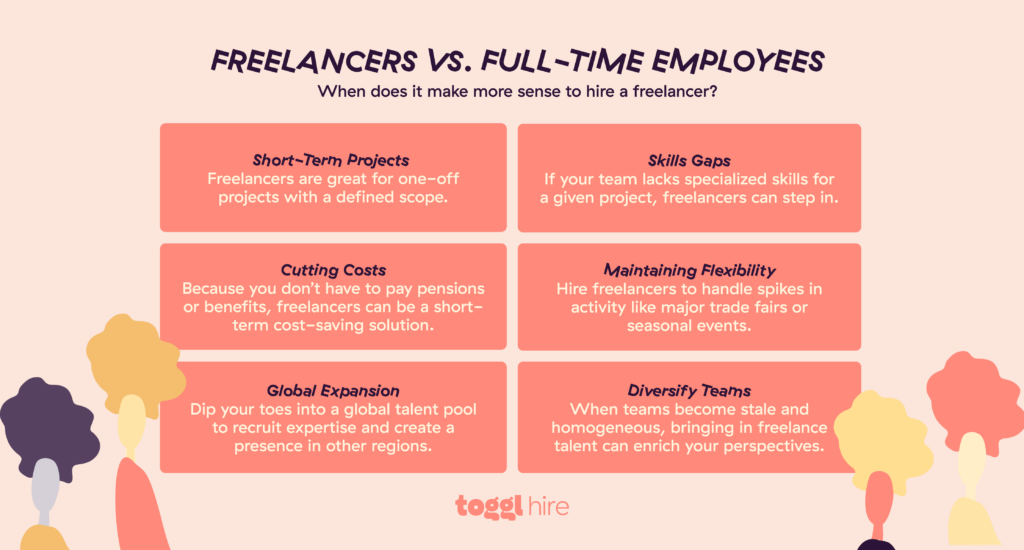
What to consider before hiring a freelancer?
Ready to upload a few job posts? Before you hit “publish,” it’s important to ensure you and your team have realistic expectations about what temporary workers can deliver and the challenges that come when you hire freelancers. Here are a few of the key drawbacks.
Short-term commitment
Freelancers juggle multiple clients, and your company may not be their top priority. As experienced workers in the gig economy, freelancers know most posts on job boards are short-term in nature. Thus, they can’t afford to become settled or lose access to business networks.
Unfortunately, this means that companies using contract workers find it harder to promote consistent brand identity and keep projects similar.
Communication breakdown
Teams of salaried workers tend to have smooth communication and established internal processes. When a freelancer is added to the mix, liaising with developers or designers can become slow and frustrating.
Quality can suffer as a result of poor communication, and managers may resort to inefficient micro-management if they lack confidence in temporary workers.
Internal cohesion and teamwork
Perhaps most importantly, relying on freelancers can erode the tight bonds between team members that make companies tick. Managers may find it hard to build trust and company morale among employees when external workers come and go.
7 steps to improve your freelance hiring process
Despite the drawbacks listed above, freelancers are a useful part of the recruitment mix. You simply need to be smart about how you source and select independent contractors. So, here are a few top tips to help you find reliable, talented people whenever you need them.
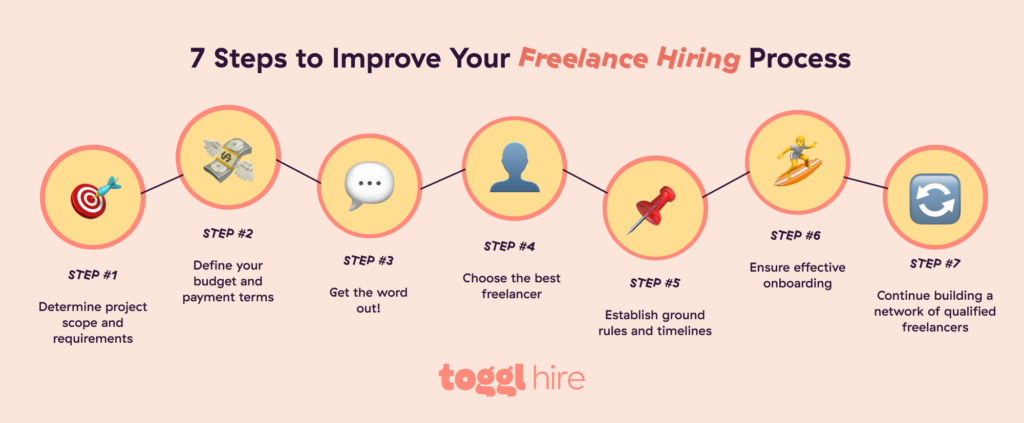
1. Determine project scope and requirements
Following the same process you use to screen and hire full-time hires. This might include:
Using job task analysis to determine critical skills
Writing a focused and informative job description that details the role and its responsibilities
Creating an ideal candidate persona to guide your selection process
Using a clear success metric to compare different candidates
Providing comprehensive information to freelancers is more important than with regular hires, as they’ll need to use that information to provide accurate quotes and terms. Take special care when crafting the job description and focus on details that help freelancers understand the role.
2. Define your budget and payment terms
The freelance recruitment process should be cost-effective. Determine a budget for each hire and use efficient recruitment tools to match candidates and roles.
When determining a budget, consider the long-term value a temporary worker will bring to your business and factor every expense into the job profile from the start.
Choose the right payment rate
Each project or role should have a target payment rate (or a range of possible rates). The rate usually balances the role’s complexity, urgency, and available resources. Generally speaking, you’ll pay more for experienced, accredited professionals.
There are other factors in play, though. For example, rates for developers are higher in Canada than in Thailand. You may be able to save money without losing quality by picking the right location.
It’s also worth noting that freelance rates also vary greatly depending on geographic location. For example, in 2022, UK market research freelancers had an average day rate of £518 ($632), while photographers averaged close to £300 ($366).
Upwork also reports standard hourly rates for the most important US-based sectors to use as a benchmark:
| Role | Average Hourly Rate (USD) |
| Coding | $60-70 |
| Analysts | $55-65 |
| Developers | $50-60 |
| CRM Specialists | $50-60 |
| Online Marketers | $50 |
| Graphic Designers | $40-45 |
| Photographers | $35-45 |
| Writers | $30-40 |
| Editors | $25-35 |
Understand freelance payments
When you hire freelancers, the first thing you’ll probably note is that their hourly rate is almost always higher than what you’d pay a permanent employee hourly. That’s because freelancers have overhead costs like paying their own taxes and health insurance.
Choosing the right payment method can also help you attract relevant talent. The two main options are:
Time-based rates
Project-based rates
If you have a fairly loose, open-ended role in mind, day or hourly rates work well. For instance, this is a good option when you hire freelancers as short-term replacements for existing team members.
If you need freelancers for fixed-length projects, it makes sense to pay a one-time project rate (until the project ends). Just remember to define the scope of the project well and include a clear success metric in the project description. This will ensure you’re on the same page and can track progress effectively.
Other payment options for niche roles include commission-based contracts if you’re expanding your sales team or bonuses for meeting specific business goals.
3. Get the word out
Freelancers won’t come to you, but fortunately, there are plenty of places to bring your job to the attention of talented candidates.
Personal networks
Up to 80% of jobs are filled via personal contacts, so consult your friends and colleagues. If someone in your personal network mentions a possible hire, take their suggestions seriously.
Whether you hire their referral or not, keep their details on file and stay in touch as your company expands. If you maintain an active talent pool, you can dip into it when needed.
Freelance platforms
If personal connections fail, using a freelancing platform is a popular option. Platforms like Fiverr and Upwork cover most industries and feature sizeable pools of active professionals.
Other platforms allow you to target freelancers in niche industries. For example, Toptal caters to coders, while Dribbble is better if you need to find freelancers with essential graphic design experience.
When you use freelancing platforms, expect plenty of interest — and not always from the best freelancers. Depending on the job board you use, be prepared to filter applicants for each job post and get ready to sift through a lot of digital portfolios.
Social networks
Alternatively, you could leverage social networks to find freelancers. LinkedIn is a goldmine in some sectors, and you can use it to post jobs and hunt for passive candidates.
Instagram, TikTok, and Facebook can be underrated when it comes to recruitment. Creatives often use them to promote their best quality work. There are also thriving Facebook groups dedicated to trades like graphic design and copywriting.
4. Choose the best freelancer
When you’ve gathered applications and exhausted your promotional options, it’s time to start the screening process.
Evaluation is a critical part of making a good hiring decision, whether you hire a freelancer or a salaried employee. Choose poorly, and you’ll have to repeat the process or deal with sub-standard work. Choose wisely, and you’ll build productive relationships with freelance experts.
Take a smart approach to candidate selection, leveraging different ways to filter applicants and assess their capabilities. There are a few methods to think about, and each has its pros and cons.
Skills assessments
Since your candidate persona already specifies core skill requirements, translating these requirements into skills assessments should be simple. Quick, accurate tests can verify that freelancers are as good as they appear on paper.
We like to connect skills tests to role-based skills templates that include technical and soft skill requirements. If you blend these tests with video interviews and other evaluation types, you can easily understand a freelancer’s strengths and weaknesses.
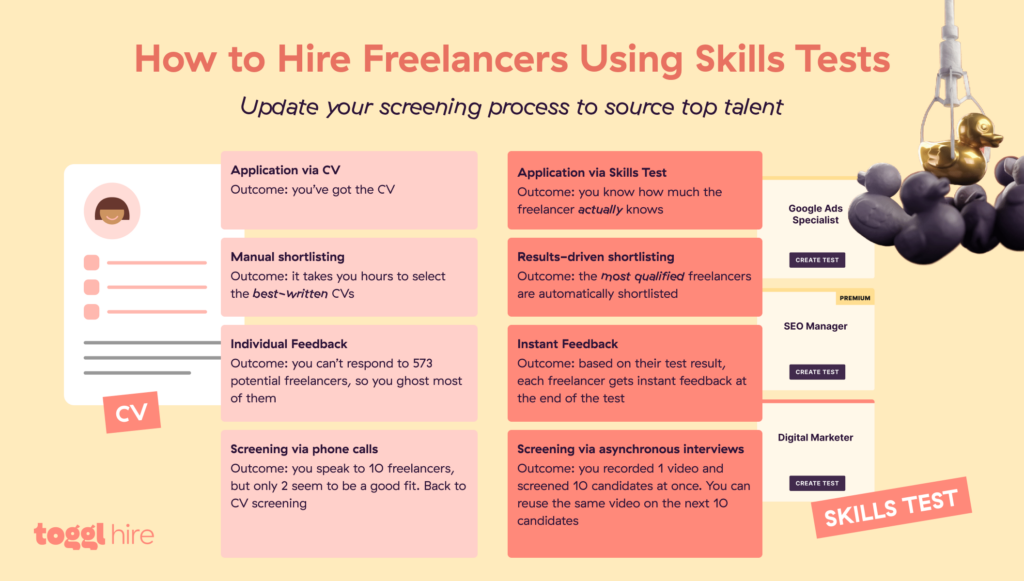
Paid trials
If you want to know whether freelancers can meet project outcomes, offer them a paid trial task. Assign freelance candidates basic projects or tasks that are connected to your intended workflow.
If you’re hiring a content writer, this might mean having them write a blog post. If you need a reputation manager, you can have them respond to client reviews using your brand voice guidelines. Assess their performance, essential skills, communication style, and speed of work.
Portfolio reviews
You’ll definitely want to ask for work samples, and portfolios provide a record of achievement. They’re a great way of showcasing creative talents and delivery records, giving employers an insight into a freelancer’s best work.
However, remember that portfolios include higher-quality work. They might gloss over inconsistencies or skill gaps. So use them alongside other assessment methods and a video interview or phone screening.
5. Set the ground rules
When hiring a freelancer, having a clear scope of work helps establish a good working relationship and manage workloads much more smoothly. Whether you’re working with someone who’s been freelancing for a year or a decade, here are some ground rules we always clarify when bringing temporary hires on board.
Set clear timelines
Define a delivery date for your project and set key milestones for the freelancer to achieve. There should be no ambiguity here. Include exactly what the freelancer needs to do, and field any questions or misunderstandings before finalizing the agreement.
Create communication channels
Because these roles are remote, most freelancers understand the nature of remote communication. Still, it’s helpful to provide a single point of contact for the freelancer and let them know you’re available to support their work. Check back regularly, especially as the project gets underway, to offer feedback.
Prioritize payments
Paying invoices is a major pain point for the business-freelancer relationship. When you hire freelancers, ensure you have the payment details you need to make on-time payments for their hard work. Agree on a payment method, and let your finance team know about the incoming invoices.
Smooth out workflows
Managers will probably need to request changes to the work produced by freelancers. Make this as painless as possible with an efficient process. Use collaborative tools like Google Docs or Notion that allow freelancers to work productively while enabling instant feedback from managers.
Talk about termination
You probably won’t need to use it, but every freelance project needs an exit strategy. When you onboard contractors, be clear about what represents a breach of contract and grounds for termination. Offer any information about relevant internal security risks, too, as a standard part of secure hiring.
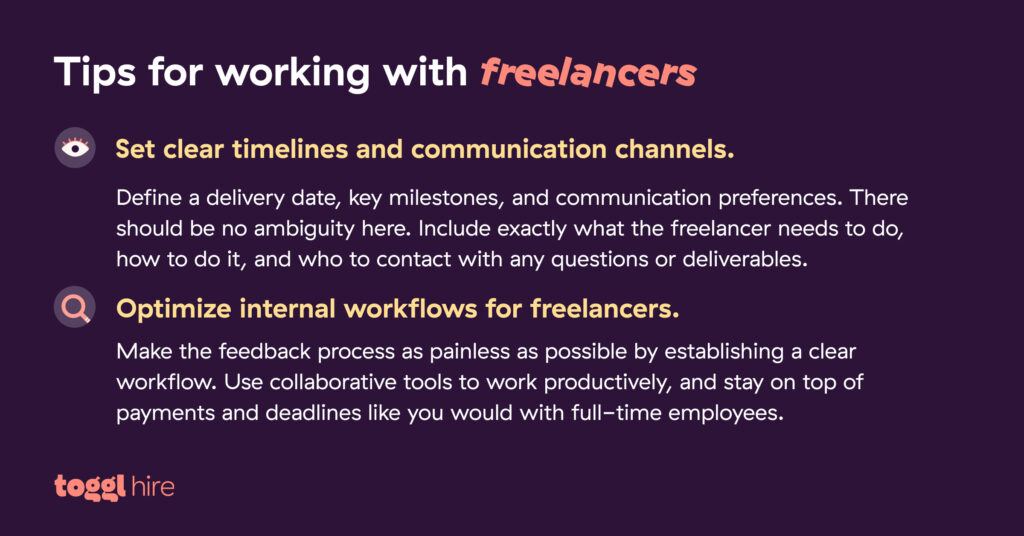
6. Ensure effective onboarding
If you want to prevent costly rehiring processes and make your workforce as stable as possible, effective onboarding is critical. The onboarding process varies between businesses and roles, but it usually looks something like this:
Introduce your company. If you want to, give presentations or provide materials that explain your business or the project scope. Digital onboarding with videos is preferable to in-person meetings, as freelancers can fit orientation into their busy schedules.
Provide core information. Tell freelancers about information-sharing policies, communication tools, house styles — anything they need to understand their job.
Provide a point of contact to raise any issues (especially early on when they’re just getting started). Contact freelancers regularly to introduce yourself and communicate project goals.
Set expectations. Let the freelancer know when to deliver their first task or check in for an assessment. That way, they can plan their work and meet project deadlines easily.
7. Build a network of freelancers
There’s often a risk of reinventing the wheel when you hire freelancers. But there’s no need to create fresh recruitment processes every time. Instead, companies can save time and money by using talent pooling to keep relevant contacts on file.
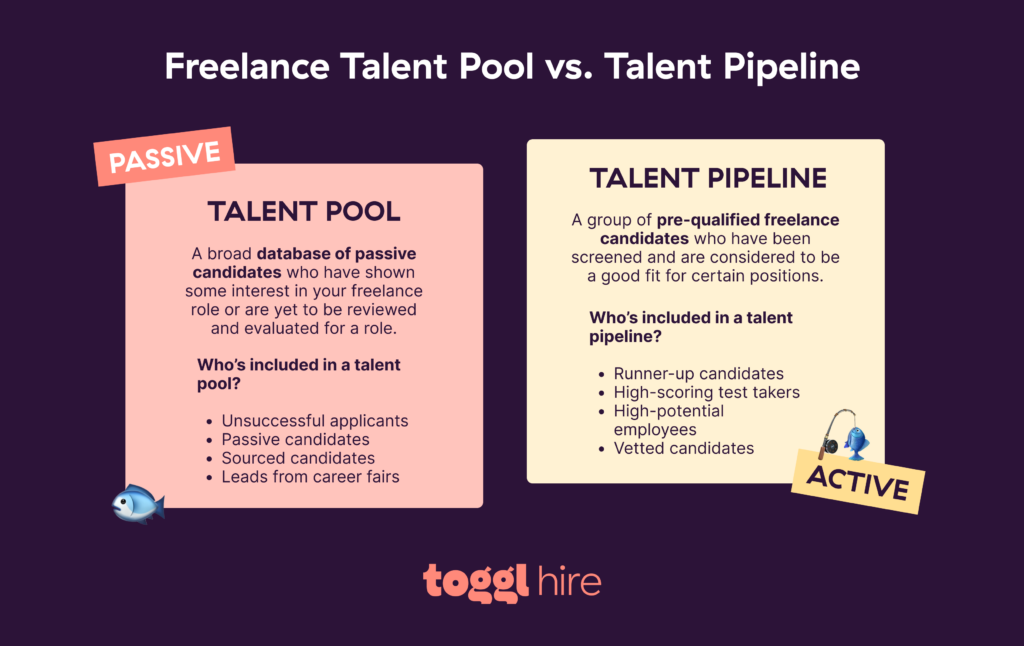
Freelancer talent pools log individuals your company has interacted with during recruitment events or previous job postings. Their email addresses, social media accounts, and phone details represent a rich resource for seeking suitable freelance talent.
Here are a few tips for using talent pools to effectively maintain strong relationships with freelancers and potential candidates:
Keep contact details on file and check in periodically to ensure you have up-to-date information. If the freelancer maintains a portfolio, store a working link as well.
Record each candidate’s relevant technical knowledge and any achievements for previous clients. This information will help you screen freelancers for specific job descriptions in the future.
If candidates don’t succeed, give them feedback. Make them feel valued, and respect the time and energy they’ve put into the process.
Link your talent pool to social media and other digital marketing channels. Integrate pool members into your socials and make them feel part of a real community.
Run training or development events for sign-ups. If you have specialized expertise that freelancers can use, share it!
Include ex-employees. When people leave your company, let them know they can come back when opportunities arise. Many people switch from full-time to freelance work later on. Why miss out if you already know their expertise?
You can create your own talent pooling systems from scratch, but pooling is even more powerful if you use our Candidate Pool feature. With it, you can store the names of previous contacts along with the results of skill assessments. You can also search your contacts database for potential hires and create groups for different projects.
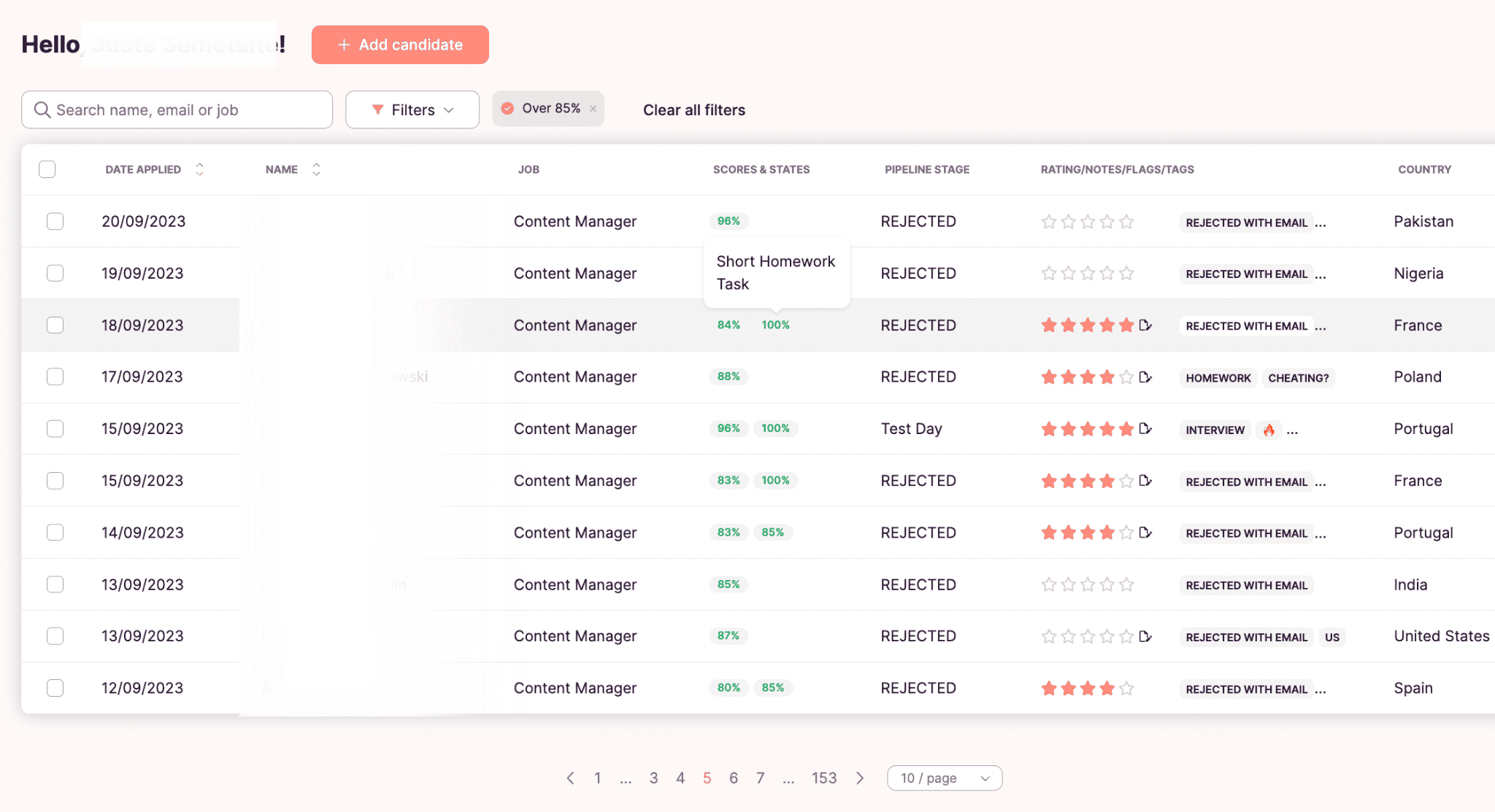
Find a good freelancer
Finding great part-time employees or freelancers is harder than it looks for most businesses. Top talent may be tucked away on a specialist freelance platform or engaged with a competitor’s job post but ready to expand their horizons.
Finding potential hires is only the first step, too. When you find the right candidates, how can you be sure you have the right freelancers for each project? Toggl Hire’s tools make hiring freelancers much simpler.
Our skills-based assessments let you verify candidate expertise and find the right match for your role. Candidates answer questions created by experts, and the results give you a crystal-clear indication of whether you’ve found the right person.
Our test library includes assessments relevant to almost any freelance situation. Whether you’re hiring videographers for a digital ad or need a direct response copywriter to maximize engagement, you’ll find relevant assessments.
Want to start sourcing top freelance talent? Browse our skills test library now to find an assessment you can start using today!
Elizabeth is an experienced entrepreneur, writer, and content marketer. She has nine years of experience helping grow businesses, including two of her own, and shares Toggl's mission of challenging traditional beliefs about what building a successful business looks like.





